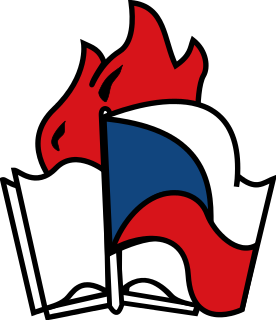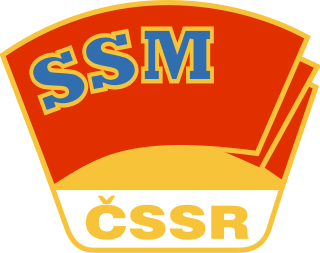
Klement Gottwald was a Czech communist politician, who was the leader of the Communist Party of Czechoslovakia from 1929 until his death in 1953–titled as General Secretary until 1945 and as Chairman from 1945 to 1953. He was the first leader of Communist Czechoslovakia from 1948 to 1953.

The Communist Party of Finland was a communist political party in Finland. The SKP was a section of Comintern and illegal in Finland until 1944.

The Third Czechoslovak Republic which emerged as a sovereign state after the end of the war was not only the result of the policies of the victorious Western allies, the French Fourth Republic, the United Kingdom and the United States, but also an indication of the strength of the Czechoslovak ideal embodied in the First Czechoslovak Republic. However, at the conclusion of World War II, Czechoslovakia fell within the Soviet sphere of influence, and this circumstance dominated any plans or strategies for postwar reconstruction. Consequently, the political and economic organisation of Czechoslovakia became largely a matter of negotiations between Edvard Beneš and Communist Party of Czechoslovakia (KSČ) exiles living in Moscow.
From the Communist coup d'état in February 1948 to the Velvet Revolution in 1989, Czechoslovakia was ruled by the Communist Party of Czechoslovakia. The country belonged to the Eastern Bloc and was a member of the Warsaw Pact and of Comecon. During the era of Communist Party rule, thousands of Czechoslovaks faced political persecution for various offences, such as trying to emigrate across the Iron Curtain.
Czechoslovakia, of all the East European countries, entered the postwar era with a relatively balanced social structure and an equitable distribution of resources. Despite some poverty, overall it was a country of relatively well-off workers, small-scale producers, farmers, and a substantial middle class. Nearly half the population was in the middle-income bracket. Ironically, perhaps, it was balanced and relatively prosperous Czechoslovakia that carried nationalization and income redistribution further than any other East European country. By the mid-1960s, the complaint was that leveling had gone too far. Earning differentials between blue-collar and white-collar workers were lower than in any other country in Eastern Europe. Further, equitable income distribution was combined in the late 1970s with relative prosperity. Along with East Germany and Hungary, Czechoslovakia enjoyed one of the highest standards of living of any of the Warsaw Pact countries through the 1980s.

The Communist Party of Czechoslovakia was a Communist and Marxist–Leninist political party in Czechoslovakia that existed between 1921 and 1992. It was a member of the Comintern. Between 1929 and 1953, it was led by Klement Gottwald. The KSČ was the sole governing party in the Czechoslovak Socialist Republic though it was a leading party alongside with the Slovak branch and four other legally permitted non-communist parties. After its election victory in 1946, it seized power in the 1948 Czechoslovak coup d'état and established a one-party state allied with the Soviet Union. Nationalization of virtually all private enterprises followed.
In the history of Czechoslovakia, normalization is a name commonly given to the period following the Warsaw Pact invasion of Czechoslovakia in August 1968 and up to the glasnost era of liberalization that began in the Soviet Union and its neighboring nations in 1987. It was characterized by the restoration of the conditions prevailing before the Prague Spring reform period led by First Secretary Alexander Dubček of the Communist Party of Czechoslovakia (KSČ) earlier in 1968 and the subsequent preservation of the new status quo. Some historians date the period from the signing of the Moscow Protocol by Dubček and the other jailed Czechoslovak leaders on August 26, 1968, while others date it from the replacement of Dubček by Gustáv Husák on April 17, 1969, followed by the official normalization policies referred to as Husakism. The policy ended either with Husák's removal as leader of the Party on December 17, 1987, or with the beginning of the Velvet Revolution on November 17, 1989, which would see the resignation of the entire Communist Party leadership within a week and an end to Communist rule in Czechoslovakia.

The National Front was the coalition of parties which headed the re-established Czechoslovakia from 1945 to 1948. During the Communist era in Czechoslovakia (1948–1989) it was the vehicle for control of all political and social activity by the Communist Party of Czechoslovakia (KSČ). It was also known in English as the National Front of Czechs and Slovaks.
Although political control of Communist Czechoslovakia was largely monopolized by the Communist Party of Czechoslovakia (KSČ) the political power was technically shared with the National Front and openly influenced by the foreign policies of the Soviet Union.
The mass media in Communist Czechoslovakia was controlled by the Communist Party of Czechoslovakia (KSČ). Private ownership of any publication or agency of the mass media was generally forbidden, although churches and other organizations published small periodicals and newspapers. Even with this informational monopoly in the hands of organizations under KSČ control, all publications were reviewed by the government's Office for Press and Information. Censorship was lifted for three months during the 1968 Prague Spring but afterward was reimposed under the terms of the 1966 Press Law. The law states that the Czechoslovak press is to provide complete information, but it must also advance the interests of socialist society and promote the people's socialist awareness of the policy of the communist party as the leading force in society and state.
With the collapse of the Habsburg monarchy at the end of World War I, the independent country of Czechoslovakia was formed as a result of the critical intervention of U.S. President Woodrow Wilson, among others.

Gustáv Husák was a Slovak communist politician, who served as the long-time First Secretary of the Communist Party of Czechoslovakia from 1969 to 1987 and the president of Czechoslovakia from 1975 to 1989. His rule is known as the period of the "Normalization" after the Prague Spring.

The Czechoslovak Socialist Republic was the name of Czechoslovakia from 1948 to 23 April 1990, when the country was under Communist rule. It was a satellite state of the Soviet Union.Following the coup d'état of February 1948, when the Communist Party of Czechoslovakia seized power with the support of the Soviet Union, the country was declared a socialist republic after the Ninth-of-May Constitution became effective. The traditional name Československá republika was changed on 11 July 1960 following the implementation of the 1960 Constitution of Czechoslovakia as a symbol of the "final victory of socialism" in the country, and remained so until the Velvet Revolution in November 1989. Several other state symbols were changed in 1960. Shortly after the Velvet Revolution, the Czechoslovak Socialist Republic was renamed to the Czech and Slovak Federative Republic.

The Warsaw Pact invasion of Czechoslovakia, officially known as Operation Danube, was a joint invasion of Czechoslovakia by five Warsaw Pact countries – the Soviet Union, Poland, Bulgaria, East Germany and Hungary – on the night of 20–21 August 1968. Approximately 500,000 Warsaw Pact troops attacked Czechoslovakia that night, with Romania and Albania refusing to participate. East German forces, except for a small number of specialists, did not participate in the invasion because they were ordered from Moscow not to cross the Czechoslovak border just hours before the invasion. 137 Czechoslovakian civilians were killed and 500 seriously wounded during the occupation.

Resistance to the German occupation of the Protectorate of Bohemia and Moravia during World War II began after the occupation of the rest of Czechoslovakia and the formation of the protectorate on 15 March 1939. German policy deterred acts of resistance and annihilated organizations of resistance. In the early days of the war, the Czech population participated in boycotts of public transport and large-scale demonstrations. Later on, armed communist partisan groups participated in sabotage and skirmishes with German police forces. The most well-known act of resistance was the assassination of Reinhard Heydrich. Resistance culminated in the so-called Prague uprising of May 1945; with Allied armies approaching, about 30,000 Czechs seized weapons. Four days of bloody street fighting ensued before the Soviet Red Army entered the nearly liberated city.
The Sbor národní bezpečnosti, known as the SNB, or National Security Corps, was the national police in Czechoslovakia from 1945 to 1991.

Pionýr, officially Pioneer Organization of the Socialist Youth Union, was a youth Marxist-Leninist organization in communist Czechoslovakia that was a subdivision of the Socialist Youth Union. Although the organisation proclaimed to be voluntary, every child was expected to join from the age of six.

The World Federation of Democratic Youth (WFDY) is an international youth organization, and has historically characterized itself as anti-imperialist and left-wing. WFDY was founded in London in 1945 as a broad international youth movement, organized in the context of the end of World War II with the aim of uniting youth from the Allies behind an anti-fascist platform that was broadly pro-peace, anti-nuclear war, expressing friendship between youth of the capitalist and socialist nations. The WFDY Headquarters are in Budapest, Hungary. The main event of WFDY is the World Festival of Youth and Students. The last festival was held in Sochi, Russia, in October 2017. It was one of the first organizations granted general consultative status with the United Nations Economic and Social Council.
Emmi Dölling was a Czechoslovak/German political activist (KPD/SED) and journalist.

The Czechoslovak Socialist Youth Union (SSM) was a mass organization which served as the youth wing of the Communist Party in the Czechoslovak Socialist Republic from 1970 to 1990. It existed alongside the Pioneer Organization, which was geared towards younger children who were expected to join the SSM in their teens. Membership stood at 1.6 million in 1982.












